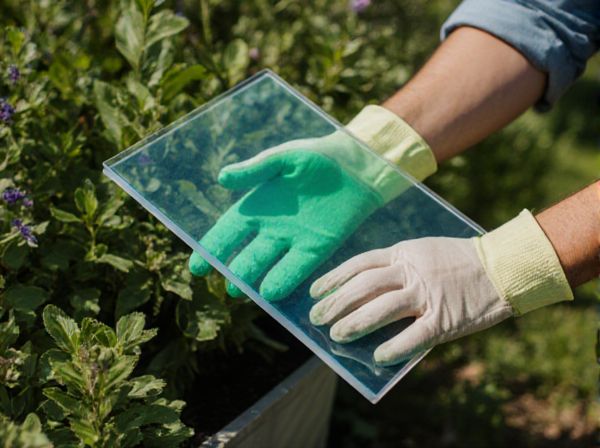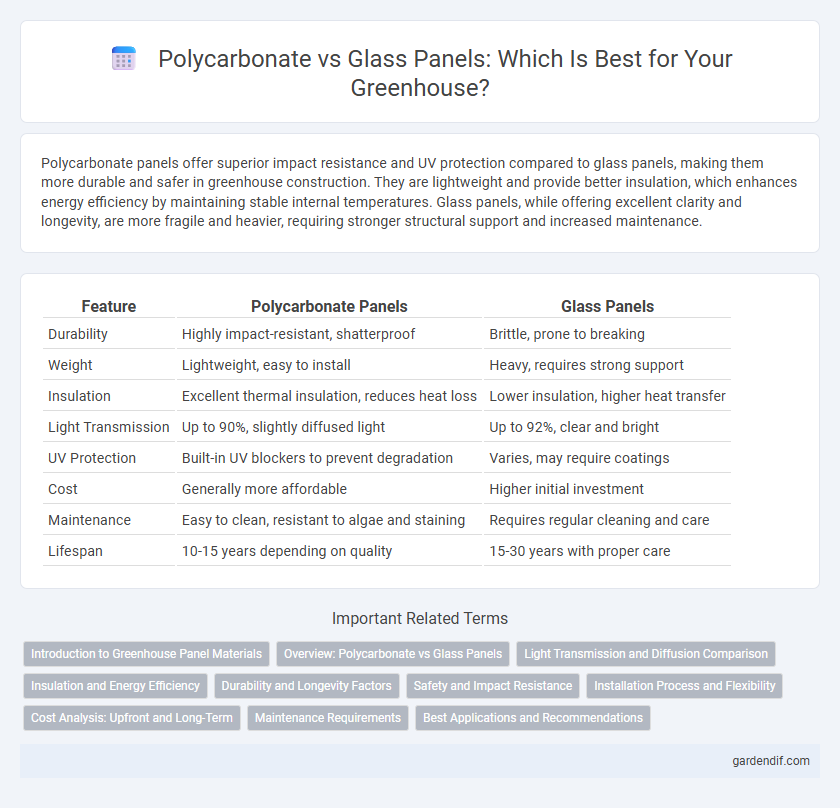
Polycarbonate panels vs glass panels Illustration
Polycarbonate panels offer superior impact resistance and UV protection compared to glass panels, making them more durable and safer in greenhouse construction. They are lightweight and provide better insulation, which enhances energy efficiency by maintaining stable internal temperatures. Glass panels, while offering excellent clarity and longevity, are more fragile and heavier, requiring stronger structural support and increased maintenance.
Table of Comparison
| Feature | Polycarbonate Panels | Glass Panels |
|---|---|---|
| Durability | Highly impact-resistant, shatterproof | Brittle, prone to breaking |
| Weight | Lightweight, easy to install | Heavy, requires strong support |
| Insulation | Excellent thermal insulation, reduces heat loss | Lower insulation, higher heat transfer |
| Light Transmission | Up to 90%, slightly diffused light | Up to 92%, clear and bright |
| UV Protection | Built-in UV blockers to prevent degradation | Varies, may require coatings |
| Cost | Generally more affordable | Higher initial investment |
| Maintenance | Easy to clean, resistant to algae and staining | Requires regular cleaning and care |
| Lifespan | 10-15 years depending on quality | 15-30 years with proper care |
Introduction to Greenhouse Panel Materials
Polycarbonate panels offer durable, lightweight, and UV-resistant qualities ideal for greenhouse construction, promoting efficient light diffusion and thermal insulation. Glass panels provide superior transparency and longevity but are heavier and more prone to breakage compared to polycarbonate. Selecting the appropriate greenhouse panel material depends on balancing factors such as light transmission, insulation, weight, and durability for optimal plant growth.
Overview: Polycarbonate vs Glass Panels
Polycarbonate panels offer superior impact resistance and lighter weight compared to glass panels, making them ideal for robust greenhouse applications. Glass panels provide excellent clarity and UV resistance, ensuring optimal light transmission for plant growth. Both materials have distinct benefits in durability, insulation, and maintenance requirements, which influence their suitability for different greenhouse designs.
Light Transmission and Diffusion Comparison
Polycarbonate panels offer superior light diffusion compared to glass panels, providing even dispersion that reduces hotspots and promotes uniform plant growth. Glass panels typically have higher light transmission rates, allowing up to 90% of natural sunlight to pass through, whereas polycarbonate panels transmit around 70-80%. The enhanced diffusion properties of polycarbonate panels improve photosynthesis efficiency by distributing light more evenly across the greenhouse interior.
Insulation and Energy Efficiency
Polycarbonate panels offer superior insulation compared to glass panels, featuring a multi-wall structure that significantly reduces heat loss and maintains a stable internal temperature. This enhanced thermal performance leads to improved energy efficiency by minimizing the need for supplemental heating or cooling in greenhouses. As a result, greenhouses with polycarbonate panels can achieve better climate control while reducing overall energy consumption and operational costs.
Durability and Longevity Factors
Polycarbonate panels exhibit superior impact resistance and UV protection compared to glass panels, making them more durable in harsh weather conditions. These panels maintain structural integrity over 10-15 years with minimal risk of cracking or shattering, unlike glass which is prone to breakage and requires frequent replacement. The lightweight nature of polycarbonate also reduces stress on greenhouse frames, enhancing overall longevity and reducing maintenance costs.
Safety and Impact Resistance
Polycarbonate panels offer superior safety and impact resistance compared to glass panels, making them ideal for greenhouse construction where durability is crucial. Their high-impact strength resists shattering and reduces injury risks, unlike glass, which can break into sharp shards under stress. Polycarbonate also withstands extreme weather conditions, enhancing greenhouse protection and longevity.
Installation Process and Flexibility
Polycarbonate panels offer a lightweight and easily manageable installation process compared to traditional glass panels, reducing labor time and costs in greenhouse construction. Their flexibility allows for curved or irregular greenhouse designs, accommodating various structural shapes without the risk of cracking common with rigid glass. This adaptability makes polycarbonate panels ideal for dynamic greenhouse environments requiring quick adjustments and durability.
Cost Analysis: Upfront and Long-Term
Polycarbonate panels generally offer lower upfront costs compared to glass panels, making them a budget-friendly option for greenhouse construction. Long-term expenses also favor polycarbonate due to its higher impact resistance and durability, which reduces repair and replacement needs. Glass panels, although initially more expensive, provide superior clarity and longevity but incur higher maintenance and breakage costs over time.
Maintenance Requirements
Polycarbonate panels require significantly less maintenance than glass panels due to their high impact resistance and flexibility, reducing the risk of cracks and breakage. These panels are easier to clean and do not shatter, eliminating the need for frequent repairs or replacements commonly associated with glass. Glass panels demand regular inspections for chips and cracks, and their fragility often leads to higher maintenance costs in greenhouse applications.
Best Applications and Recommendations
Polycarbonate panels outperform glass panels in greenhouses due to superior impact resistance, lighter weight, and better thermal insulation, making them ideal for commercial and hobby growers seeking durability and energy efficiency. Glass panels offer excellent light transmission and longevity, recommended for high-end greenhouses where maximum natural light and aesthetic appeal are priorities. Select polycarbonate for environments with harsh weather or risk of breakage, and reserve glass for stable conditions demanding premium clarity.
Polycarbonate panels vs glass panels Infographic

 gardendif.com
gardendif.com